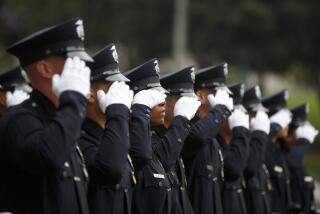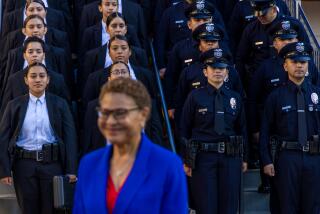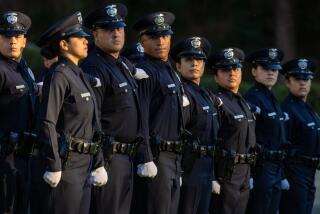Police Recruits Brush Up on Law, Guns--and Watercolors
- Share via
NEW HAVEN, Conn. — In addition to learning about the law, defensive tactics, and firearms at the Police Academy, Shawn Browning also discovered the power of watercolors.
To teach communication skills and tolerance, the city Police Academy requires all recruits to engage in some form of artistic expression.
A group of recruits in the current class put on an original one-act play. A second group put on an art exhibit.
“These are people who have never been to an art exhibit in their lives, so it’s a new way of thinking for them,” said academy director Kay D. Codish, the program’s creator.
For Browning and four other recruits in his group, that meant visiting museums for the first time and taking instruction from local artist Eileen Doktorski.
“I don’t think they’re going to leave the police force to be artists, but I think their work is terrific,” Doktorski said.
The group decided to use their art to send a message about child abuse. They took common household objects like a bar of soap, a spatula and a belt to show how seemingly benign items could be terrifying in the eyes of an abused child.
The objects are painted in bright pinks, blues and hues of purple that might be found in a child’s bedroom and are shown on colorful shelves.
A collection of blue belts and extension cords hang from one shelf. On another shelf is a sculpted hand with a burning cigarette branding it. The cadets also included customary phrases of discipline, such as “You’ll be sorry you did that,” or “Don’t make me hit you again,” which is painted in pink on a blue baseball bat.
Their exhibit, “Things That Hurt: When Discipline Goes Too Far,” is on display at police headquarters.
“Art is much more than pictures on a wall,” said Browning, 26. “I hadn’t realized that.”
This city’s Police Department has gained a reputation in recent years for embracing progressive programs. New Haven was an early adherent of community policing, getting officers out of their cars and out on foot patrols to interact with the community.
Codish said the training in the arts is an extension of that community-policing philosophy.
More to Read
The biggest entertainment stories
Get our big stories about Hollywood, film, television, music, arts, culture and more right in your inbox as soon as they publish.
You may occasionally receive promotional content from the Los Angeles Times.










